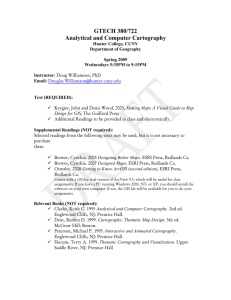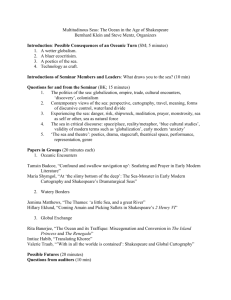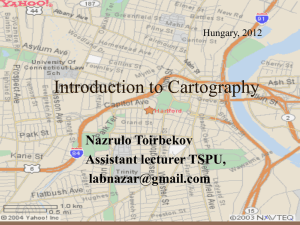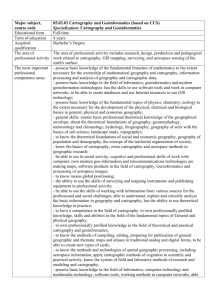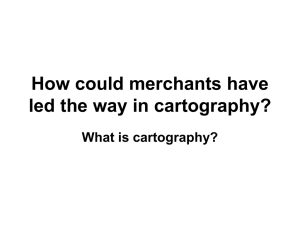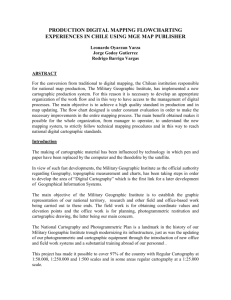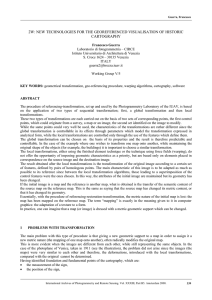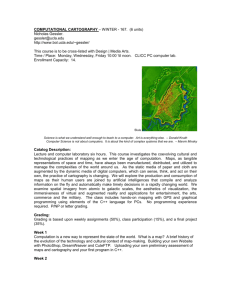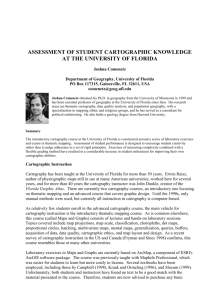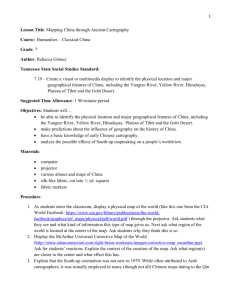Applications - International Cartographic Association
advertisement
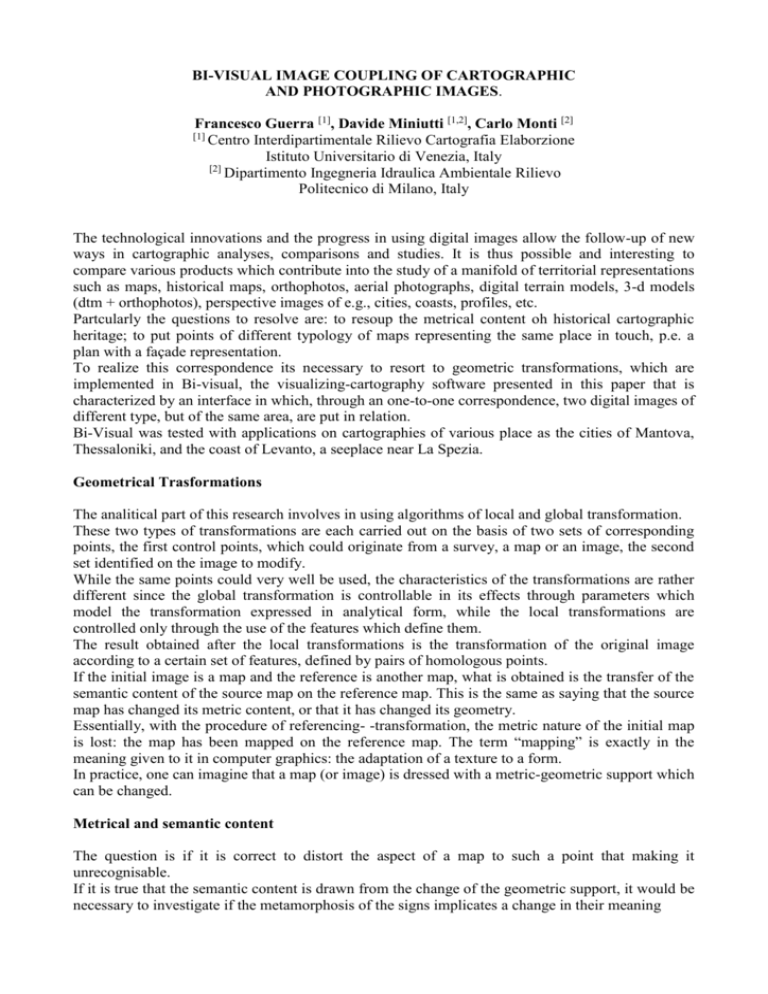
BI-VISUAL IMAGE COUPLING OF CARTOGRAPHIC AND PHOTOGRAPHIC IMAGES. Francesco Guerra [1], Davide Miniutti [1,2], Carlo Monti [2] Centro Interdipartimentale Rilievo Cartografia Elaborzione Istituto Universitario di Venezia, Italy [2] Dipartimento Ingegneria Idraulica Ambientale Rilievo Politecnico di Milano, Italy [1] The technological innovations and the progress in using digital images allow the follow-up of new ways in cartographic analyses, comparisons and studies. It is thus possible and interesting to compare various products which contribute into the study of a manifold of territorial representations such as maps, historical maps, orthophotos, aerial photographs, digital terrain models, 3-d models (dtm + orthophotos), perspective images of e.g., cities, coasts, profiles, etc. Partcularly the questions to resolve are: to resoup the metrical content oh historical cartographic heritage; to put points of different typology of maps representing the same place in touch, p.e. a plan with a façade representation. To realize this correspondence its necessary to resort to geometric transformations, which are implemented in Bi-visual, the visualizing-cartography software presented in this paper that is characterized by an interface in which, through an one-to-one correspondence, two digital images of different type, but of the same area, are put in relation. Bi-Visual was tested with applications on cartographies of various place as the cities of Mantova, Thessaloniki, and the coast of Levanto, a seeplace near La Spezia. Geometrical Trasformations The analitical part of this research involves in using algorithms of local and global transformation. These two types of transformations are each carried out on the basis of two sets of corresponding points, the first control points, which could originate from a survey, a map or an image, the second set identified on the image to modify. While the same points could very well be used, the characteristics of the transformations are rather different since the global transformation is controllable in its effects through parameters which model the transformation expressed in analytical form, while the local transformations are controlled only through the use of the features which define them. The result obtained after the local transformations is the transformation of the original image according to a certain set of features, defined by pairs of homologous points. If the initial image is a map and the reference is another map, what is obtained is the transfer of the semantic content of the source map on the reference map. This is the same as saying that the source map has changed its metric content, or that it has changed its geometry. Essentially, with the procedure of referencing- -transformation, the metric nature of the initial map is lost: the map has been mapped on the reference map. The term “mapping” is exactly in the meaning given to it in computer graphics: the adaptation of a texture to a form. In practice, one can imagine that a map (or image) is dressed with a metric-geometric support which can be changed. Metrical and semantic content The question is if it is correct to distort the aspect of a map to such a point that making it unrecognisable. If it is true that the semantic content is drawn from the change of the geometric support, it would be necessary to investigate if the metamorphosis of the signs implicates a change in their meaning The fact remains that, in general, the assignation of a correct metric support is highly important for the use of this cartography, not only as an archive document, having a qualitative nature but rather as real cartography from where quantitative information can be taken. For this reason, warping technics are used not to transform geometrically but as analitical base for the correspondence between different maps. Pratically the warping techniques can be used not in order to transform the maps but in order to create correspondence(Guerra 2000). The analitical part and the algorithms of the procedure implies global transformation united to local transformation (warping). It is possible to image that the relations between pixels in the source image and the destination image are resolved in a definitive way at the time of sampling in the final image for the transformation procedure, while in correspondence, it is resolved quickly and visualised in real time. Bi-Visual software Its name, Bi-visual, is inspired by the fact that the screen is organised into two windows where are loaded differents maps. In these, on the left window, the reference cartography (a today cartography which geometry, in terms of system of reference and of projection, is known) is visualised and on the right, the map to transform. Bi-visual can be considered as the development of another software, 2WIN, always written by the authors (Guerra 2000). As in this previous software, the methods of functioning are quite commonplace: by identifying a point on one of the two maps, the program calculates the position on the other and highlights this by centring the two windows on homologous points. The centre of the two windows is always on two corresponding points. The method of calculation to use implements, as it’s said before, algorithms of local transformation, based on points or lines, borrowed from the morphing techniques of computer graphics and properly adapted to cartography. The novelty is in the problem of the research into the nearby features tht has been resolved by implementing a “quadtree” structure for the memorisation of the features themselves. In this way, the research into the nearby features and the calculation of the homologous point have given acceptable response times. In fact quadtree is a procession of recursive decomposition, where each area is divided into four parts. Those parts are then further subdivided till the decomposition reach a much finer level: theoretically partitioning proceeds until there is only one spatial feature contained in each quadtree tile. Quadtrees are often used as space-ordering methods, that is two-dimension space is mapped into one dimention creating a linear sequence that can be used as a spatial index . These index values can be calculated directly from x,y coordinates using a tecnique known as Peano Codes or Peano Curve, that is used to speed the location of nearby spatial objects. Quadtree structure Peano curve and the research nearby features method Applications As it was explained above, Bi-visual can be used not only to relate different historical cartographic documents of a same place (cities, territories) but even to find corrispondences in different tipology of representations. The first case-study is about the urban development of the historical centre of Mantova: having the actual city-maps, a series of digitised historical images and several aerial photographs taken in different epochs of time, it is then possible and in short time to make evident or to unveil alterations in the morphology and structure of the city during the years. Loading in the left window the image of a reference cartography and on the wright one some image, one a time, corresponding to different period in teh history of Mantova, it’s possible to show in a clear and intuitive way the changes of territory along centuries (p.e. the reclaimed area of the socalled “third lake”; the sign of ancient towers, that can be still seen in the aerial photos of 1944; the Cittadella place). The city of Mantova in a historical topographic map dated 1800 and in CTR 1:5000, underlying the so-called “third lake” and the sign of ancient towers Maps used in the cartographic comparison Scheme of Bi-visual working Some frames of Bi-visual displaying the correspondence of map. The blu cross shows homologous points The research, moreover, permitted to analyze some morphological transformation of the greek island of Kithira, comparing a topographical survey dated 1990 with a map of Coronelli of the XVII century. About plan and fronts corrispondences, the cartography of a coastal place has been studied with the respective front view. In this case, the software allows the "navigation" on the map along the coast and visualises automatically the correspondent point on the perspective image. This application allows the rapid and low-cost verification of eventual new constructions and other alterations on the coast and in the aside zones. It is also possible to replace the map in the leftwindow with a simple aerial photograph. For this application, datas are referred to the place of Levanto, from Punta dei Marmi to Punta Mesco, a part of coast in Liguria near La Spezia, as first exemple, and to the see-front of Thessaloniki. Correspondences between plans and fron view for coast documentation: Thessaloniki (left) and Levanto (wright) Conclusions The Bi-Visual software allows to identify corresponding points and therefore also the calculation of the co-ordinates in the system of the reference map. To identify points and to know the co-ordinates of these points are fundamental operations which are carried out on the cartography such as localisation and measurement. The software designed and implemented in this way realises in a conclusive way the idea of returning to the historic cartography a strict metric support without however modifying the original aspect. This would suggest reflecting on the possibilities offered by the use of informational instruments in the field of cartography, and not only of historic nature. This software proved to be an efficient tool of comparison in the study of cartographic data of different origin and age, which was not possible to realise otherwise. In addition it is intuitive in operation and indeed user-friendly allowing the direct access also to non specialists who are, more or less, not familiar with the use of modern digital technologies, e.g., historians, archaeologists, administrators etc. Bibliography Antico Gallina Maria Vittoria, Dall'immagine cartografica alla ricostruzione storica, LED, Milano 1994; Beier T., Neely S., Feature-based image metamorphosis, in Proceeding of Siggraph'92, 1992; Bugayevskiy L. M., Map Projection. A reference manual, Taylor &Francis, London 1995; Castleman K. R., Digital image processing, Prentice Hall, Englewood Cliffs 1996; Clarke C. K., Analytical and Computer Cartography , Prentice Hall International, London, 1995; Fuse T., Shimizu E. Morichi S., A study on geometric correction of historical maps, in International Archives of Photogrammetry and Remote Sensing vol XXXII, Part 5, Hakodate 1998; Glassner A. S., Principle of digital image processing, Morgan Kaufmann, S.Francisco, 1995. Gomes j., Darsa L., Costa B. Velho L., Warpimg and morphing of graphical objectcts, Morgan Kaufmann Publishers, San Francisco 1999; Guerra F., Local geometric transformation of images for the restoration of cartography, in Atti del 5th Hellenic Cartographic Conference “Large Scale Cartography: City Maps”, XEEE, Salonicco, 25-27 Novembre 1998. Guerra F., 2W: new technologies for the georeferenced visualisation of historic cartography, in ISPRS, vol. XXXIII, part B5/1, Commission V, ISPRS, XIX Congress, Amsterdam, luglio 2000. Ligorio G., Le basi del morphing, in Computer Programming, n°20, giugno 1995; Magagno Maurizio, Effetti speciali: morphing e warping, in Computer Programming, n°69, maggio 1998; Magagno Maurizio, Field morphing, in Computer Programming, n°70, giugno 1998; Mason D. K., I segreti del morphing, Tecniche Nuove, Milano, 1995; Melli P., L’elaborazione digitale delle immagini, Franco Angeli, Milano 1991; Pratt William K., Digital Image Processing, John Wiley & Son, New York 1991; Rocchini C., Morphing, in Computer Programming, n°20, giugno 1995; Scott E. Umbaugh, Computer Vision and Image Processing, Prentice Hall International, London,1998; Smith A., Planar 2-pass texture mapping and warping, in Proceeding of Siggraph'87, 1987; Watt A., Policarpo F., The computer image, Addison-Wesley, New York 1998; Zamperoni P., Metodi dell'elaborazione digitale di immagini, Masson, Milano 1990;
